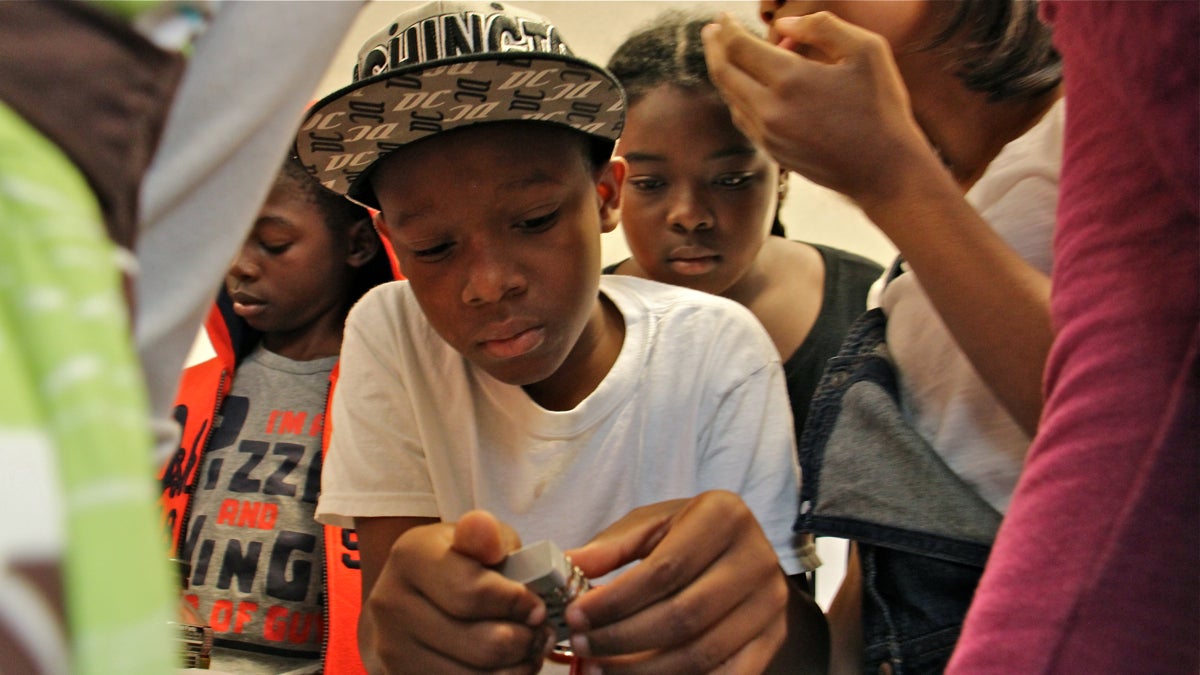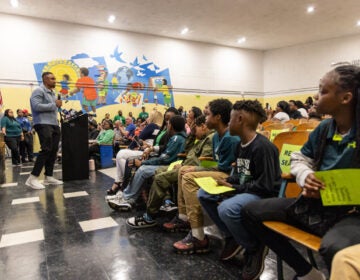With new middle school, Science Leadership Academy looks to prove itself

Students at Science Leadership Academy Middle School use clues to figure out how to open a locked box in their classfoom. (Emma Lee/WHYY)
Though students arrived two weeks ago, Science Leadership Academy Middle School in West Philadelphia held its official ribbon-cutting Tuesday.
And with that, so begins one of the more intriguing experiments in Philadelphia education.
Science Leadership Academy Middle School — or SLA-MS as it is affectionately known — will serve 88 fifth-graders this year, with plans to become a 360-student, fifth- through eighth-grade middle school over the next three years.
In style and substance, the school will largely resemble Science Leadership Academy, the experimental high school in Center City that has become one of Philadelphia’s academic bright spots in the decade since its founding. SLA-MS — like SLA — will receive support from the nonprofit Inquiry Schools and focus on project-based learning where students pose and solve their own problems.
There is, however, one key difference. SLA is a special admission school that accepts only relatively high-performing students. SLA-MS will be a neighborhood school, with its doors opened to any child in the surrounding area who wants to attend.
“This allows us to prove that this inquiry-based model can and will work with children in neighborhoods,” said district superintendent William Hite.
For at least the first two years of its existence, SLA-MS will operate out of Drexel University’s Dana and David Dornsife Center for Neighborhood Partnerships in Powelton Village. It will reserve spots for all students from Samuel Powel Elementary School, a K-4 school located a short trot away.
Eventually, the two schools plan to share one campus on the site of the old University City High School that was shuttered it in 2013.
Evolutionary process
In many ways, University City’s demise and SLA-MS birth tell the story of Philadelphia education over the past five years. Since 2011-12, population loss and charter growth have caused the district to close 35 schools — many of them traditional, neighborhood schools. Over the same period of time, the district has opened 11 schools — often centered around a progressive educational vision.
Just last week, the Philadelphia School Reform Commission approved creation of a “Big Picture Learning” school where Roberts Vaux High School once stood.
In 2015, Philadelphia formed an Innovative Schools Network to coordinate and incubate this growing network of experimental schools. All but one of the eight schools in the network became official district high schools at some point in the last five years.
SLA-MS stands out from the bunch because of its catchment-based enrollment policy. Of the 88 students enrolled there this year, 50 came from Samuel Powel Elementary. The other 38 come from 24 different ZIP codes, said SLA-MS principal Timothy Boyle, with the majority from greater West Philadelphia.
Powel had no true feeder-pattern middle school prior to SLA-MS, said SLA founder and Innovative Schools Network chief Chris Lehmann. SLA-MS will fill that vacuum. There were only 60 fourth-graders at Samuel Powel last spring, said Boyle, meaning SLAMS retained 83 percent of Powel graduates in it first year.
SLA-MS officials hope that percentage will grow. They also hope to expand Powel’s capacity by moving it to a new campus and adding another class per grade. “There’s really no way to grow it in the existing building,” said Lucy Kerman, Drexel’s vice president for University and Community partnerships. The ultimate goal is for Powel students to fill all 90 seats in SLA-MS’ fifth-grade class.
The conversion of Science Leadership Academy into a neighborhood middle school shouldn’t be conflated with “turnaround” efforts at low-performing district schools. Powel does relatively well on the district’s measures for academic achievement; on its latest School Progress Report, it ranked fifth out of 59 peer schools across the city.
In addition to drawing from a high-achieving elementary school, SLA-MS will have the advantage of a $1.6 million startup grant from Philadelphia School Partnership. The grant will cover professional development for teachers, temporary facilities costs, academic materials, curricular support, and new technology. There will, for instance, be a separate laptop for every student enrolled.
Still searching for money
There is still, however, one major money issue that remains unresolved. It will cost somewhere in the neighborhood of $45 million to build a new school that can house SLA-MS and Samuel Powel. Drexel and Wexford Science and Technology LLC purchased the land for the building in June 2014. Drexel or a third party will own whatever school building is constructed on the property and lease it to the School District of Philadelphia for a nominal fee, according to Kerman.
The lingering quiestion is who will pay to build the structure. Drexel says it doesn’t have the capital to erect a new school. “We were very clear that we did not have the ability to build a public school building,” Kerman said. Neither does the school district, according to Kerman.
Together the partners hope to raise about $25 to $28 million from philanthropists, she said, and pay for the rest by relying on the type incentive-laden financing schemes commonly used to spur public development. She named new market tax credits, tax increment financing, and neighborhood improvement districts as types of programs that support such projects, but stressed there is no final decision on how the new building will be financed.
Still, Drexel is hopeful it can raise the money, especially now that SLA-MS is up and running.
“We feel like the wind is at our back,” Kerman said.
On the surface, this new project would seem like Drexel’s answer to Penn Alexander–the popular elementary school in West Philadelphia that emerged out of a partnership between the district and University of Pennsylvania. There are, however, some key differences.
Penn Alexander was built with public money, and the school district ultimately purchased the property. The University of Pennsylvania also provides ongoing, per-pupil support to Penn Alexander. Finally, Penn Alexander was an entirely new school. Drexel is hoping only to combine two existing schools in an upgraded facility.
For the love of learning — and animal crackers
If and when that facility opens, SLA-MS will already be well into its journey.
On Tuesday, SLA-MS fifth-graders were brushing up on their digital citizenship skills in order to make better use of those technological toys. Rather than sit still and recite the do’s and dont’s of life on the internet, they used their knowledge to solve clues related to the subject matter. Those clues then allowed them to open a padlock attached to a secret box. The prize for opening the box? A handful of animal crackers.
“They are searching for their own answers,” said teacher Meredith Martin as giddy children buzzed about the classroom. “I’m not directly telling them what to do. They’re trying to figure it out on their own.”
Before landing the job at SLA-MS, Martin taught for 18 years in New Jersey, most recently in Mantua Township, Gloucester County. There she had opportunities to experiment with new forms of teaching, but nothing quite like the freedom she has in her new gig.
“This is like my dream school,” she said.
Correction: An earlier version of this article stated that the nonprofit Inquiry Schools would “run” SLA-MS. Inquiry Schools will act as a partner, but SLA-MS will be a traditional district school.
WHYY is your source for fact-based, in-depth journalism and information. As a nonprofit organization, we rely on financial support from readers like you. Please give today.





